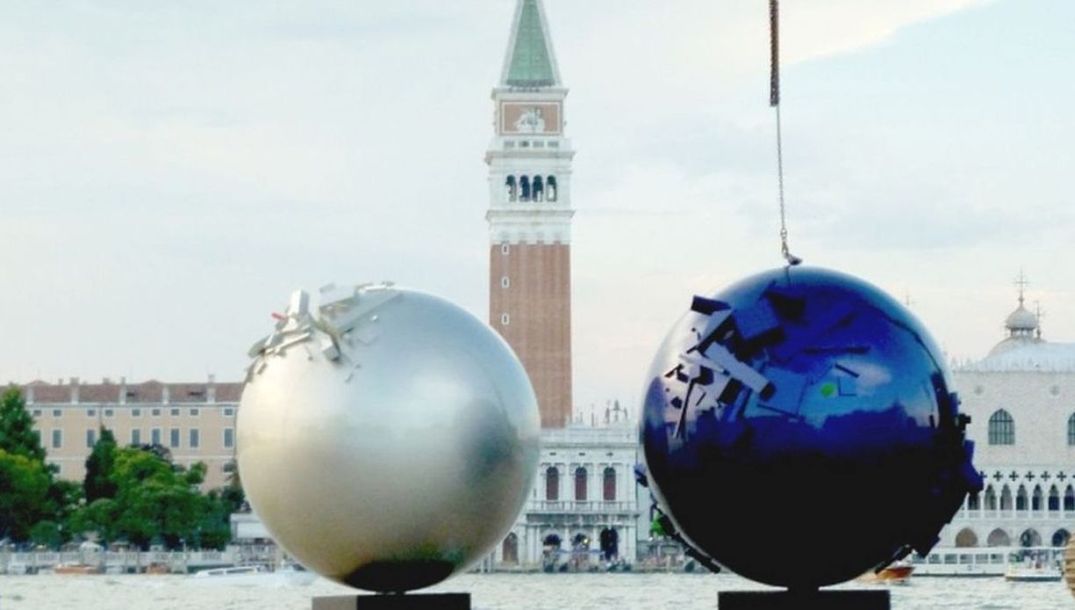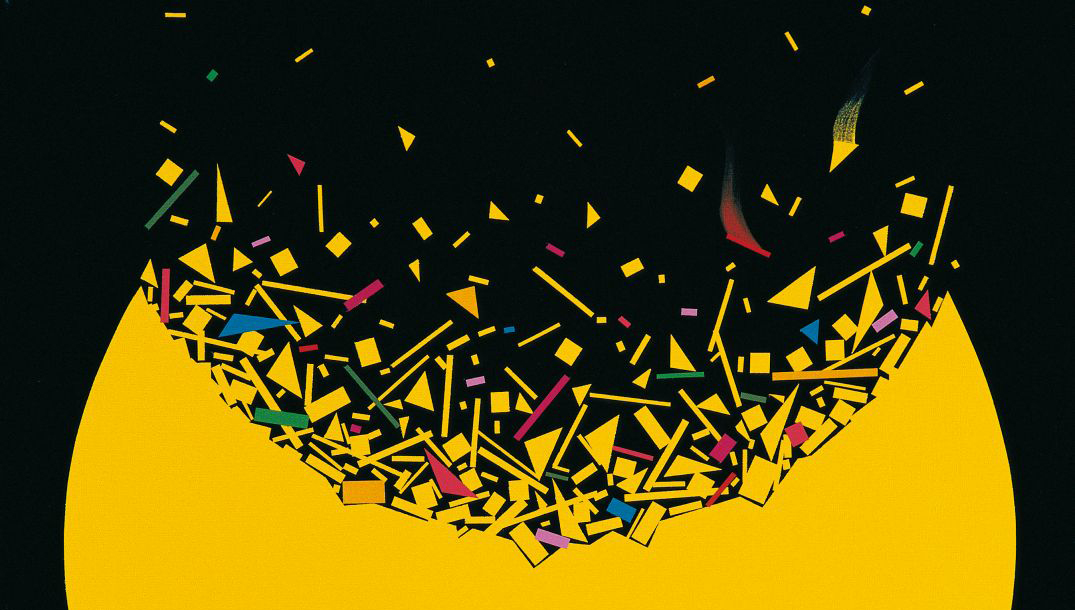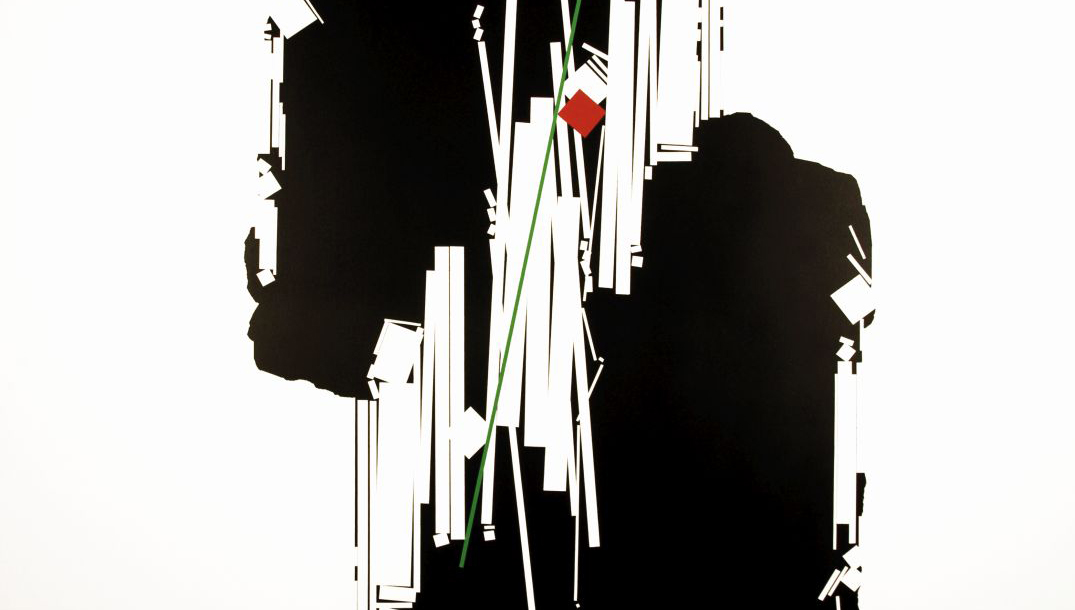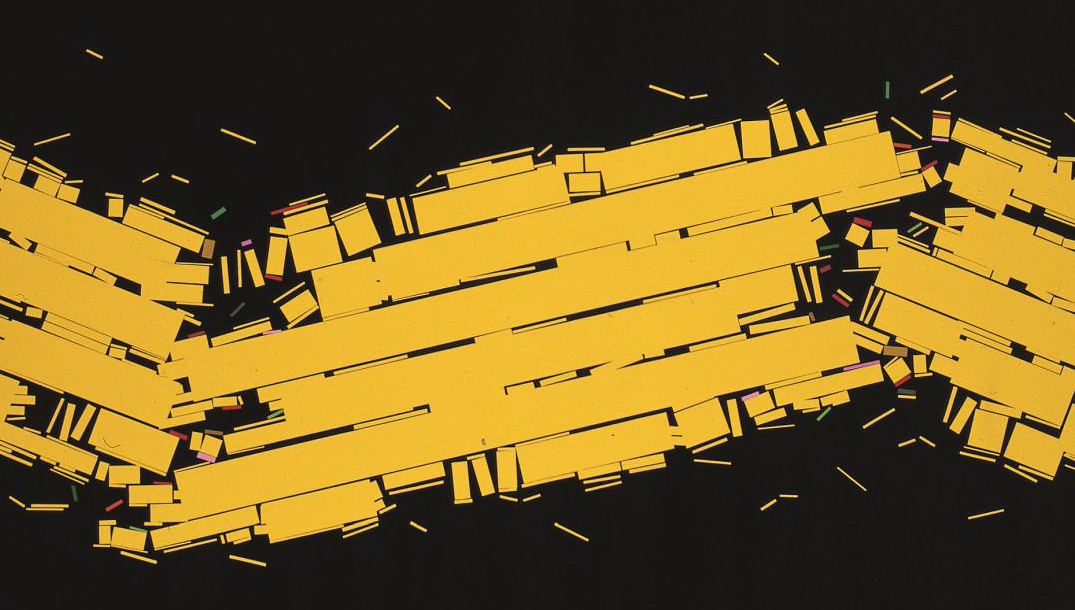Gillo Dorfles Milano 1983
Beppe Bonetti has understood that our present situation, from an aesthetic and sociological point of view, is not the one of the mathematic rigorism any more; of the geometric form and static schemes. In fact his painting is based on a precise choice of transgression of the symmetry, that is real explosion of the close and static forms. This is showed through the last series of his acrylic paints, often precious for the matter and the chromatic modulation. It is an alternation of segments really regular but often digressing towards an unexpected direction, it is the intersection and superimposition of straight lines that throw the apparent order of the paint into a vital confusion; it is a shading of the chromatic element dipping into an achromatic or dark limbo, going towards an invisible horizon. It may be a compulsion and an interpenetration of broken lines towards the pursuit of an ambiguous and autonomous dimension.
Beppe Bonettis purpose is not to reach a volumetric space, or an authentic flat surface, but, may be, his purpose is the conquest (the artist has called his last works in this way) of something similar to the Abbott's Flatland where men and women, animals and plants are simply bi-dimensional segments completely flat; living of their absurd and unlikely life, where their vicissitudes are the image of the living that ourselves are deceiving to try, in a total space, but it is only the specular image of our flattened life. This would be the same for one who was looking us from his high tetradimension, for us unimaginable and mysterious.
extract from catalogue Beppe Bonetti Metarazionalità, GAM Editrice, Rudiano (BS), 1995
Enrico Crispolti 1985
The latest paint of Heppe Bonetti accent a kinetics which is interior at the establishment of the formal structure, already discernable in the canvas he did some years ago, and now yet rendered expliciter because it has become essential into the iteration of lineal segments, the graphics though chromatic valency, on a compact and anonymous ground, like a black-board. A page that cannot be crossed over, a field which space is made void however resounding in its basic chromatical neuter value.
In some way these paints register an event of coming derangement. Remembers almost a structural reality invested by an unexpected movement, by a sudden dynamical crossing.
The one that Bonetti remembers us is therefore the reality of a structural kinesis, the evidence of structures of kinetic relativity.
In a regular woof of lineal chromatic segments, analogously disposed, in a kind of rhythmic road, inserts itself really an interference of the rhythm itself (lineal as chromatic), which causes a variation of that woof, in that road: cuts into slices the first like in a fall, opens the second like in a progressive divarication, to which corresponds a chromatic graduation. This is fundamentally the road of a basic melodiousness, of rhythmic iterative scansion in the elementar measure, till its variation, rendered therefore quite relative. On the canvas resolves upon therefore a rhythmic asymmetry as dynamical event, which Bonetti not only registers, but causes and then pursues and at last documents. In this way his paint is certainly a kind of theatre in rhythmical fractions of an iterative order of lineal units on a compact and neuter ground.
I don't believe that is exact to mean the imagination of Bonetti as parascientific, or demonstrative of a strictly mathematical thought. The precision that Bonetti shows exists in the measure of the possibility to show itself such also into the changes, into the divarication, and then fundamentally the relativity. In conclusion what Bonetti means to watch over is just the possibility and the necessity of change, of diversion, as vitality that is inner to the structural condition, I would say at topologic level, more than not simply of pictorial evidence.
presentation on personal exibition at Matisse Gallery, Barcellona january 1985
with Enrico Crispolti
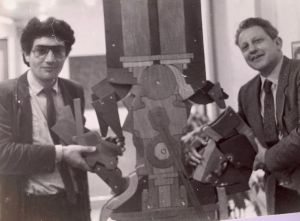
Metarazionalità by Maurizio Sciaccaluga 2005
A Greek word, Meta-rationality: what is beyond, above, transcending reason. A name, the label chosen by Bonetti to describe his a-iconic painting. A concept: it holds the poetics of an artist who has made of abstract research the reason of his painting. Meta-rationality is order and disorder, logical and illogical, rule and chance, construction and destruction symmetry and asymmetry, rhythm and arrhythmic, harmony and disharmony; it is not a static concept, but it is moving, and its action is to put disorder in order, illogical in logical, chance in rule, destruction in construction, asymmetry in symmetry, arrhythmic in rhythm, disharmony in harmony. It has a very strong acceptation for this artist from Brescia, it means to know the rule but, at the right moment, to break it. To see the world by a squint-eyed sight, to look for reason in not-reason. To mistrust both instinct and ratio. To call it equilibrium would be a big mistake, for Meta-rationality is also made by instability. It is better to speak about a strategic place where the opposite can live together, in fact it is exactly in the middle, between reality and unreality, clearness, linearity and chaos. Meta-rationality: in a concept the expression of Bonetti's extremely coherent, analytic, determinate painting. At the same time, it is never the same, never held in fixity of forms. His art is at its ease between a rigid and rigorous programming, and a free and nearly instinctive invention: so, a privileged position, reached by the artist's capability to wander about the artistic currents, to know them deeply, to meditate them critically and to elaborate them again. From here he goes on with goals of construction, study and destruction, and of reconstruction of the imagine again. In his acrylics the whole history of the Abstractionism is signed, for example there is Casimir Malevic's suprematism of works like The black cross or Red and black square, transcending every contact with the exterior object and exploring universes not contaminated by the rules of objective space-time, and so stating the art's reality must reveal cosmic reality as lacking of objects. Also Bonetti is looking for absolute purity, which can be expressed in space only by the apparition of primary symbols. "The world is not objective, and there are not goals to reach. Not-objective world is a goal. The practical reality of things is unreal", Malevic said. Suprematistic absolute essence and form, Bonetti's painting inherit something by Vladimir Tatlin's constructivism too, thrown to a project and operative function of art. And by Piet Mondrian's neo-plasticism. The new spirit, as the Hollander said, destroys the form, delimited in the esthetical expression, and rebuilds an equivalent appearance of subjective and objective, of contents and container. The form is cut out to obtain this neo-plastic vision. Ab-trahere, a word from Latin which means to take off, to reject, to let go: it is a continuously taking off to reach the pure form, to express the essence of simplification. An ideal, abstract representation of planes which balance each other in space with a mathematical precision of plastic relationships, like an architectural composition. The influence of the Russian master Vasilij Kandinskij is recognizable too. And much more the influence of Paul Klee who, even if he shares Kandinskij's tension to spirituality and abstraction, pursues a very different research, by a deeply excavation of appearances and their transformation in a simplified, not naturalistic vision. It is the connecting link between the ordered world of music and the chaotic, disquieting, ungovernable one of unconscious. In a word: Bonetti's art is the regaining of rationality, of method, against the forms of an exasperated individualism. The objectivity in the century of the extreme and extremist subjectivity. He surely belongs to that artistic category where the intellectual datum is more evident without leaving a purely pictorial field. That is, there is a mental instance which influences, manages, controls the gesture, always poised between the image and its negation, between the tilling and the emptying out a space. Bonetti has a unique great aim: to give a sense and a concreteness to the multiform ways of poetry's event. Poetry, then, can be reached or it can not. He looks for the perfect synthesis and he does the most with the least.
He refuses the mathematical severity of shut forms, of inflexible and static geometrical modulus, he breaks symmetry and the established order. His works on canvas represent the explosion of shut forms, but they are only apparently regular segments, more often they deviate to an unexpected directionality. Straight-lines which cross and superpose one each other, and put into the picture's illusive order a vitalizing upsetting. His forms give the impression of a continuous movement, they fluctuate in the surrounding atmosphere and constitute vortexes and unexpected out-flections. So, they determinate a situation of entropic disorder, as Gillo Dorfles defined it. Freer forms, continuously moving lines. More than twenty years ago, Bruno Munari wrote that Bonetti's images are the visualization of an esthetical, structural and poetic thought. In scientific field, Pythagoras' theorem is the visualization of a mathematical thought. In artistic field, Piero della Francesca, Mondrian, Arp, Bill try to make an esthetical thought visible. So, in front of Bonetti's works, it is useless to look for a literary meaning or for the representation of something belonging to an outer reality, but it is better to observe them as the bearer of an out-of-reason message: the visualization of a way to structure the form, to occupy a space with two or more dimensions. Bonetti uses the line to paint, for the point is silent, while the straight-line is movement, it speaks, it starts a dialectic with the nearby line, it accumulates and thickens and constitutes a pictorial thickness, new images, full forms. Then they are absorbed by the background and he starts again, documenting, by the becoming of lines and forms, a pictorial, human, historical time which is very close to Heraclitus' one and to his panta rei. The colour takes part to the composition, and so.he alternates dark blue settings, monochromic blend of grey and brilliant chromo-yellow, the colour of divinity. Subject and setting represent the poles between the artist discusses his discourse on order against disorder, rationality versus unpredictable.
Essay published on catalogue Beppe Bonetti Metarazionalità edited by Maurizio Sciaccaluga, Edizione Galleria delle Battaglie, 2005
Rudolph Rainer 2008
Works of Beppe Bonetti made from the second half of the sixties until the end of 1977/78 should be collocated in a context of a pure research, initiated to question possible operating directions and techniques which used to improve aesthetic project, still faraway from being characterized and followed with determination. Beppe Bonetti in his research of autonomic space traces and retraces a history of avant-garde manifesting from the beginning a favor towards a direction of a non-iconic research and that we can define "abstract", with a particular attention to works of Wassilij Kandinskij but especially Paul Klee. Also the Constructivism of Malevitch and sterile researches of De Stijl will present an important reference, not only in years of formation, but also as a paradigm of future conceptual operations that rise up from work and great personalities as Mondrian and Malevitch. In those years Beppe Bonetti does not stop his raid in fields of surreal figurative matrix that soon were exhausted to give space for severe research of a structure and color.
In 1978 in the work of Beppe Bonetti rise an essentiality of representative elements; primary figures as squares and lines on monochromatic and compact bases are aligned, one on other, sometimes multiplied as an echo of a structural and chromatic scanning coming from paintings, as if this representative elements are rising in chronometric rhythms from canvases. By using acrylic color and its technical possibilities the artist is able of strong and surprising programming of the system (structure) and chromatic (color). Nucleus of this works, mostly made on canvas, is documented in this volume and represents a well defined period in which predominates constructive and rational aspect. This works, perfect by a technical/executive point of view, do not leave any space to casualty, but are a cold, exact and determine representative intent, even if they still preserve a surreal atmosphere. Those were years of frequent contacts with Italian artists as Munari, Nigro, Perilli, Veronesi,Cavellini, years of continues travels to Paris (compartment 119, railway 2) with Demarco, Morisson, Garcia Rossi, Gaul and years when his work exposed in Grand Palais in Paris on the occasion of Sallon D'Automne organized by French petrol company Elf Antar Gaz was sold.
1982 is the begging of a new phase. LA LINEA (the line) become the only factor, to which, Beppe Bonetti trusts all possibilities of presenting structure, color, space; order, rhythm, harmony and also, for the first time, messing up rationality - disorder, casualty and non-predictable. It is the begging of most fertile, fantastic and changing moments in the work of the Italian artist, which he calls METARATIONALITY, ambitious temptation to combine in synthesis of an artwork, two basic factors of human work: order is disorder, a chance and a rule, rhythm and arrhythmia, logic and what is not logic... as has written Beppe Bonetti in a poetic manifest. "It does not help to close the eyes and feign that reality is easily changeable only with reason, maybe is more efficient finding another reason, another order, and another rationality. METARATIONALITY." Rationality that characterizes entire artists work from this moment on is not anymore denied but it dialectically pones itself as "the first and maybe the less complex part of the artwork to be completed". In this artworks, a proliferation of segments invades the surface, accumulates and it makes layers by prospective beating of the space, evading or re-declaring rules of gravity. Lines are moving, thickening, cover and hitting one another, sending signals. If the dot means silence, as wrote Kandinskij in Dot, Line, Surface the line on the contrary speaks. Thin lines, sometimes very thin and hardly seen mark monochromatic surfaces combining continuous process of rhythmic and chromatic variations. In the eighties Beppe Bonetti got to know Sol Le Witt and Morellet and he observed their work from a certain distance. The METARATIONALITY, on the contrary, registered other variations by following new directions.
In 1987 the work of Bonetti is touched by further variations. The line, which has been a basic wedge – almost a modulo – of his painting, seems to contract and thicken until it layers and constructs geometric forms. Previous is almost a total disintegration of other structures that are not lines, as organic fragments of dissolved forms. He leaves once again the space to monochromatic draftings, tone by tone and often grey on grey or grey on black. From this period we know two canvases of size 160 x 80 of grey tone on black entitled, that is why their chromatics, omaggio a Burri. As a symbolic use of color, the use of "grey object" will soon be counter with yellow chrome object of some bigger canvases to give significant contrary point to non color. Apollineian color of light, contrary to Saturnian's non color of lead. Once again as a path of knowledge refers to alchemy.
VARIAZIONE SU UN ERRORE DI PARMENIDE [Variations of Parmenides error] is a title of a series of works that develop by starting with circular structure. As many times artist said, a Greek philosopher is cited to provoke, to mark artworks that start from a circle and question possible variations. By taking as a pretext the definition of Being ...that is, and of non being that is not... and from relative contradiction ...that it does not have past and no future, but only the present, in this similar to a round sphere... Beppe Bonetti performs a series of two-dimensional variations transposed on canvas where the circle assumes step by step an aspect of vessel of color or absence of color; it becomes a full object or an empty space, positive or negative in the infinite combination possibilities.
VARIAZIONI SUL NUMERO 7 [Variations of number 7]. From the middle of the eighties, the sign of Beppe Bonetti, reduced to the essentiality of a line, becomes reorganized in thick orthogonal cross hairs traced to divide and space groups of segments, positioned in new combination possibilities. They are assembles of seven lines of different lengths combined in vertical, horizontal, diagonal way and infinite intermediate possibilities. Substantially extrapolated from causality of their positions in surfaces produced in those years, that here adopt other values, other semantic and communicative value. Because six would not be enough and eight would be to much, however seven was for its literary, symbolic and mythic fullness a particular number says Beppe Bonetti. Developed and traced for dozen thousands times in different measures and chromatics, this groups of seven lines present a phase of still open artist's work.
Essay published on General Catalogue Volume 1 Beppe Bonetti Christian Maretti Editore 2008
Ilaria Bignotti 2009
Beppe Bonetti. Meta-rationality and more.
...the anachronism of writing to record (or wanting to record) the anachronism of a profession: that of the painter...1 Beppe Bonetti's work was born after: after the avant-gardes of order and disorder2, after the spirit in conflict with matter, after the synthesis of the thesis and the antithesis, after the madness of the subconscious and the obsessions of the Conscience.
After – not later than – the Suprematists' square and Neo-plastic compositions.
His inquiries began in order to throw light on a new relationship between parts: at the cost of risking a fall into the irrational; managing to save himself by grabbing hold of the last remains of form; suggesting slight hopes for the rationalism that raves within the irrational.
...to impose exactness on oneself in order not to end in chaos...3: to create a silently put-together method, without too much clamour, and rejecting Marinetti's brusque complaints against moonlight4 and the decadent Laguna.
Even before working as an artist Beppe Bonetti works on himself: a long training that still continues, demonstrating the need for interior investigation that is necessarily translated into a personal rethinking of the whole of art history, from Cranach to Kandinsky, from Hartung to Burri and Fontana5, in search of works in which there might be evident a synthesis born of negation, form derived from the uncertainties of formation; with the courage to admit that it is impossible to arrive at the truth; with the courage of aspiring – of only aspiring to...
The artist reached this point of arrival and departure in the early ‘eighties, right in the middle of the surging tumult of the Trans-avant-garde and Post-modernism and… expressionist attempts...6. It was Gillo Dorfles who from 1983 onwards, shortly after the creation of Meta-rationality, pinpointed and upheld the validity of its historical references and its work in a contemporary context 7.
Dorfles was the founder of that Concrete Art movement which, shortly after the end of the Second World War, insisted on the applicability of the researches of Van Doesburg and Max Bill as a way of superseding the polemics between Realism and Abstraction. In the same period Bruno Munari too affirmed that in Bonetti's work one could find a kind of research that might fill the gap between nature and history, reality and abstraction by a slow and fertile meditation on those aspects of art which began with Piero della Francesca and arrived at Mondrian, Arp, and Bill. Researches in which the natural element and real facts are translated into a valid, working abstract form, one capable of answering the needs of function, the rules of life, and the dictates of nature: How to observe the venation of a leaf or to discover the rules of a mineral's growth..., the works by Bonetti are a search, according to Munari, for a meeting point between the visualisation of mathematical and rational thought, and the incontrovertible presence of an aesthetic dimension 8.
He was irresponsible enough to follow the thorny path of questions previously asked by such people as Pevsner, Gabo, Bill etcetera; impassioned enough to avoid, without being backward-looking, the later successful journeys of Cucchi, Chia, and Clemente. From the ‘eighties onwards Bonetti continued with a research into the limits of exact vision by working on the combinatory possibilities of a given number of segments placed in a non-calculable way, but intermediate with respect to the vertical, the horizontal, and the diagonal: it was, at the end of the day, a valid meta-rational approach to the problem, one with its roots in personal thoughts about the variations of Parmenides and the fragments of Heraclites.
Philosophy, mathematics, geometry, and slow painting beneath the whiplashes of chance, error, and the unexpected: in search of a new vision of things, of the structure of forms that were all the more exact because of being unexpected, the more complete because they were open, the more true because they had slipped through the cracks of madness.
...colour must be the colour of something that is precise and determined, it cannot be a fog wandering over the surface, but a precise choice that ‘structurally' underlines an idea that is represented; this is why I aim at colour being the structure of my work, and vice-versa. Without uncertainties. To all men (and artists too?) it is given to know themselves and not to go beyond their limits. Heraclites (fragment 76)9.
He opens up geometric, inflexible, and static modules; he begins with the indestructible rigour of the Suprematists to lose himself in the labyrinths of Borges; he overcomes chilly formal rigour, between Moscow and Byzantium, to hover in the land of iridescent Orphism and in the alchemy of The Spiritual in Art. This explains the bristly-haired mouse the artist has outrageously represented next to the face of Mondrian or Malevich: an animal, the result of biological-evolutionary madness, together with the artist, an artist insofar as he is the contriver of forms emerging from rational madness, from an excess of rationality that touches on mysticism, from a faith in order that explodes into chaos; both, man and artist, are the symbol of a rational model madly accepted by the West.
Going beyond such models of the universe as those suggested by Leibniz or Einstein, and moving towards a new existential mode at the edges of abstraction and reality, construction and revolution created Meta-rationality: forms explode, quake, resist the new; they shatter into a thousand fragments, coagulate, rise up and open sideways.
Beppe Bonetti's work insists on our sense of responsibility.
It asks us to take a position.
It forces us to think.
It allows us evasion.
The synthesis lies in the drama: drama inasmuch as it is a staging, in the style of the ancient Greeks, of a dialectic opposition; it is a game between the Apollonian and the Dionysian which, more than ever today, we feel we are taking part in: the amazed actors of an unstable panorama without a horizon on which to rest our eyes; the post-atomic inhabitants of a hybrid metropolis, sons and fathers of dispersed relationships, of unexpected reactions, of distorted connections, of missing consequences, and of interrupted causes.
The latest stage of Meta-rationality was the formation of the L.I.G. group 10, the Last International Group, consisting of Beppe Bonetti, Rudolph Rainer, and Milan Zorocic. Its manifesto was written in the first part of January 2001, a year after the beginning of the third millennium; it was a McLuhan-like global, and therefore intercontinental, village, Bonetti has said11.
This was a further step forward, and thus a new proof of his ability for reading behind the scenes (of history, form, and the idea of art), one which made of Beppe Bonetti an international artist and also a completely free one because he was forced to express himself. A meta-rational artist. And (much) more.
Note:
1 From Beppe Bonetti, Metarazionalità – sette anni in frammenti, Udine, Campanotto Editore, 2005. This diary/essay is subdivided into days to allow, not just the following of the artist's formal and theoretical interests, but also a construction of the thoughts that led him to found the L.I.G. group; it also gives priceless hints about how to analyse philosophical and literary texts.
2 For the opposition between the avant-gardes of order and disorder see M. Calvesi, Le due Avanguardie, Milan, 1966.
3 Beppe Bonetti, Metarazionalità – sette anni in frammenti, op. cit..
4 The provocative suggestion to kill moonlight is to be found in Discorso futurista di Marinetti ai Veneziani, part of the manifesto Contro Venezia Passatista, signed by Marinetti, Boccioni, Carrà, and Russolo on 27 April 1910: ...Venice... worn out by her centuries-old voluptuousness, and which all the same we loved and possessed in a great nostalgic dream… the magnificent wound of the past... was to be freed from its ...mercenary moonlight like a furnished room... in the hope of the reign of electric light: Venice, then, was considered a metaphor for that longing for the past that the Futurists had declared war on in the name of a revolution against all traditional forms of expression. Let's kill moonlight was, then, the recurrent call symbolising the social-cultural revolution that Futurist poetics aimed at.
5 Beppe Bonetti, Metarazionalità – sette anni in frammenti, op. cit.
6 G. Dorfles, presentation essay in the exhibition catalogue for Beppe Bonetti's show in Alassio, Galliate Arte Contemporanea gallery, October-November 1983.
7 For the critical debate about Beppe Bonetti's work, and for a careful study of his career, I suggest perusal of the recent anthology Beppe Bonetti, Metarazionalità. Antologico 1968-2006, essays by E. Bonessio di Terzet, G. Dorfles, B. Munari et al., exhibition catalogue, Rovato, church of San Vincenzo, 28 October-6 November 2006, Colorart 2006
8 B. Munari, presentation essay in the exhibition catalogue for Beppe Bonetti's show, Galleria Vismara, Milan, 1983.
9 Beppe Bonetti, Metarazionalità – sette anni in frammenti, op. cit.
10 For more about the L.I.G group I suggest a perusal of the critical-philosophical essay by Fernand Furier, Paris, June 2002, published in the catalogue of the show L.I.G. METARATIONALITY, Brescia, 2002.
11 Beppe Bonetti, Metarazionalità – sette anni in frammenti, op. cit.
Read the article in japanese language
Sandro Orlandi Stagl 2011
Meta-rationality: the denial of becoming.
Beppe Bonetti's work basis is rational thought seen not in a practical way, but rather in a philosophical one as mankind's ability of thinking, pondering, answering to the deepest questions life can ask. The fact that he dealt with issues raised by Parmenides was not accidental, but a specific and reasoned will of considering mankind through a possibilistic key to the reading. As the ancient Greek philosopher, Bonetti assumes as the core of his research the cosmic question, being able to think as a purely human characteristic, the origin of mankind, of its land and thought.
The artist's evolution carries on emphasising the meaning of becoming, of the transformation of things that changing gives origin to other things.
And so elements breaks and other elements arise form them; countless segments spill over into space while worlds multiply and generates other worlds. According to Bonetti space is endless, in his works it has no limits even if it is represented and circumscribed in the canvas small dimension.
Even if they are balanced and defined, his works never turn out to be concluded, but they are part of a whole that has not yet appeared, part of an infinite to which the artist keeps address.
Beppe Bonetti feels the need to face space with thought to reveal a whole that becomes being and change into an atmosphere belonging to worlds that have knocked out pragmatic barriers.
In this sublime process, spheres represent spectator's total participation and, at the same time, the medium through which the artist knocks out the wall of third dimension and in so doing he goes beyond the mythical Pillar of Hercules of knowledge.
Sphere is on one hand a fragment of a larger universe and on the other a separate world that takes the shape of an independent life in a dynamic and not-perceptually-concluded way.
It is not possible to perceive the sphere in its entirety: no matter how hard one tries, a part of its surface remains hidden. This involves the user's active participation, s/he urged by thirst for knowledge undertakes the "circumnavigation" of that perfectly smooth and unarguably charming surface.
Fragments seem to come out from matter's tears and questions acquire an even more intimate character accompanying us in the reflection about what is and what is not.
In his On nature poem, Parmenides claims that Being's reality is unchangeable, uncreated, continuous, immortal, unique, homogeneous, motionless and eternal.
According to the Greek philosopher Truth (alethèia) is round, so sphere is an indication of sublime perfection and is given by reason, not by opinion; it is perfect because it is the only geometric solid that has no differences in itself, it is always the same whatever our point of view is. Such hypothesis will agree with Albert Einstein's theory of relativity, in 1900 he will say: "If we take a pair of binoculars and point it to the space, we would see a closed line to infinity" in every direction of the space, that is overall a sphere. Therefore universe would turn out to be a sphere, although it is infinite, made of a space bent over itself.
Beppe Bonetti takes into consideration a very keen mistake on a philosophic level to elaborate it on an artistic level afterward: in the cited considerations Parmenides admits a finite space inside the sphere, where the being is placed, and one outside the sphere where instead is identified non-being. But how can one admit a space outside the sphere without admitting elements in that space? If the space exists than also the possibility that in that space there are objects exists.
Beppe Bonetti has based his elaboration on Parmenides conceptual "mistake" he put emphasis on little strokes, colours and other fragments that cross, superimpose and exist outside the sphere's border. Not only. The presence of these fragments that, according to Parmenides, should not-be (because they are outside the sphere) becomes the work's appeal: it is what makes the art a vision; it is what attracts and intrigues.
The cycle's title Variazioni su un errore di Parmenide (Variations on a Parmenides' mistake) recall therefore that thin border between being and not-being that is not definable by thought and grammar, but perceptible through art.
Bonetti does an operation that is the base of the whole contemporary art: make the invisible becomes visible.
Enlightenment. Emotions.
"Variazioni su un errore di Parmenide"
(Variations on a Parminides' mastake)
When Parmenides elaborated his philosophical thought he could not imagine that 2.500 years later a very refined Italian artist would decide to represent in his works of art the parody of one of his concepts.
Not one of the many concepts, but the central one, the one around which the whole thought of Parmenides revolve: the definition of Being!
This concept is so pervading that Being necessarily had to identifies itself the universe in its spatial and temporal totality to such an extend that when Parmenides wanted to compare it with a sphere, one and only solid that is the same from every point of view, he made a mistake because he gave borders to something that has not got them by definition.
That work becomes Beppe Bonetti's spirit to parody with endless variations what "is not" painting objects and spaces that are no longer part of the sphere, that do not go in or out.
Almost without wanting it this parody becomes something deeper because Parmenides' unproduced and immortal, perfect because based on the TRUTH (unique and absolute), Being includes also the man an entity that lives in perennial mistake, basing his existence on opinion (that is on the many pseudo-truths, or better one of the many mistakes about the unique and absolute Truth) and so every work (that is every variation on a Parmenides' mistake) in some way represents man, every one of us.
That is why, looking at those prefect, shiny, metallic spheres, our eyes chases after the small, projecting, metal solids, the cracks, the colours... we are looking for ourselves, our opinions, our faults in those works that wishes torepresent, or maybe ogle parodying, Parmenides' Being.
These extraordinary works shine of an inner light that comes from far away and that Beppe Bonetti sends us to incite us to think.
|
|
|
Beppe Bonetti. Metarationality
Text by Sergio Mandelli (Pralina n. 40)
The protagonist of this episode is Beppe Bonetti, born in 1951 in Rovato, a small city in the Brescian territory, that has been home to important artists, among whom stands out Moretto, an Italian Renaissance painter. Yet, more than from Moretto, Bonetti acquires a deep interest in painting from Gerolamo Calca, an important post-bohemian painter. But the world is so immense that it can offer us countless reference points. So Bonetti, in the search for his artistic identity, revisits some 20th century fundamental art movements. First and foremost, he looks to surrealism as an academy for the elaboration of forms, and a fruitful laboratory of colors. Then he shows inclination for geometric abstraction, tending towards optical art. The year 1982 marks the turning point in his artistic career.
Bonetti realizes that rationalism has lost its primary role in art. Rationalism, the artistic movement that, at the beginning of the 20th century, seemed to be an unexplored and promising territory, turns out to be a dead-end street. Therefore Bonetti feels the necessity to embark on another dimension. He nurtures a passion for philosophy, coins the term Metarazionalità, in which the prefix Meta stands for over.
Whereas the geometric abstraction has taught Bonetti the line and the bi-dimensionality, he now tries to open up the forms, and to decompose them into their elementary components. The Vismara Gallery in Milan, alongside with other important galleries, organizes his first important shows. Gillo Dorfles and other competent art critics have written about Bonetti. According to Dorfles, Bonetti has understood that our epoch "is imposed on the precise choice of transgression of the symmetry, of the falling apart of the established order, of the explosion of the closed and static forms".
With this concept in mind, Bonetti has executed various series of works. The first series presents segments of different colors that seemingly fluctuate in a monochrome atmosphere, as parts of a scaffold that suddenly gives way. But most of the time, it’s the same segments that, when reassembled, give life to the original structure seen through the negative, as in the case of the circle.
Bonetti’s attempt to reorder the scattering signs in the space can be seen in the series titled Variations of number 7. Attracted by the arithmetic and symbolic values of this number, Bonetti creates a reticular structure inside the cells of which we can notice infinite variations of seven segments of diverse lengths.
Another series - perhaps the most representative of his idea on Metarazionalità – deals with a geometric form shattered into fragments of different sizes. But Bonetti’s paintings can be interpreted in an inverse way: there are fragments in the space that try to recompose themselves to give shape to a definite figure.
At the basis of these artworks there exists a reverence for the idea that the richness of art is the result of the gradual absorption of all the styles that have been developing since man’s origin. This idea is well highlighted in a video labeled Don’t forget, derived from Marcel Duchamp.
Bonetti’s works have obtained wider and wider recognition, so much so that since the 1980s they have been exhibited worldwide, in countries such as Holland, Japan, Korea, the States and France.
The work I’m presenting you is from the series Variations of an error of Parmenide. Parmenide was the first Greek philosopher that meditates on the question of Being. Being, according to Parmenide, is evocative of a perfectly spherical form.
Already in those days, Platon pointed out incongruities, errors regarding Parmenide’s theory. Bonetti takes inspiration from these errors; thereby he realizes perfectly circular, monochrome forms, on the border of which stand out geometrical fragments such as rectangulars, triangles, squares. On other occasions it’s the sphere itself that undergoes the process of breaking off.
This series also includes sculptures of great beauty. In fact, as artist, Bonetti knows well that there are domains of thoughts and human expressions – as in poetry- that draw inspiration from the rigorous principles of geometry and logic.
But what distinguishes him is his fight against the belief that tries to subdue all authentic knowledge exclusively to things that are scientifically verifiable.
Bonetti’s art features a nostalgia towards a reassuring art, in which the geometrical structure can put everything in order. But above all, his art bespeaks a nostalgia towards the spiritual aspiration of human dimension that remains forever inexpressible.
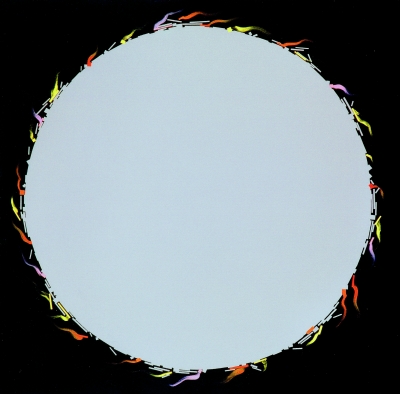
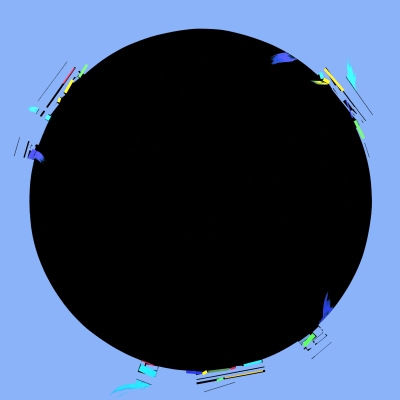
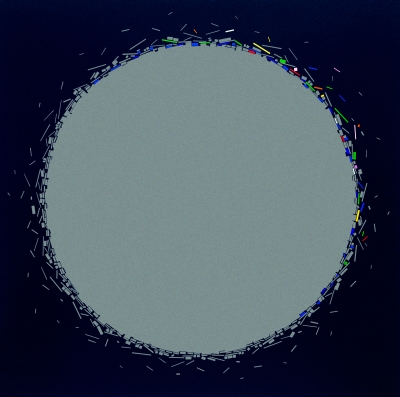
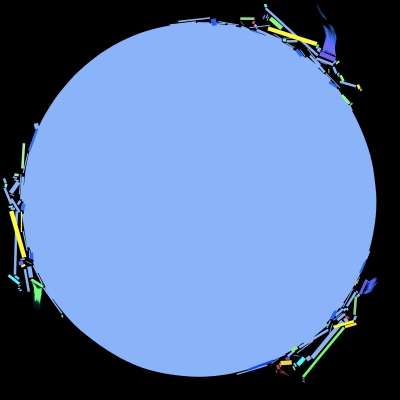
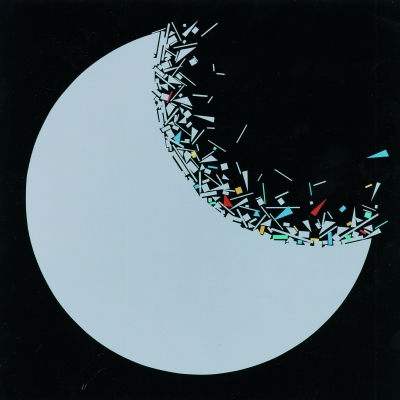
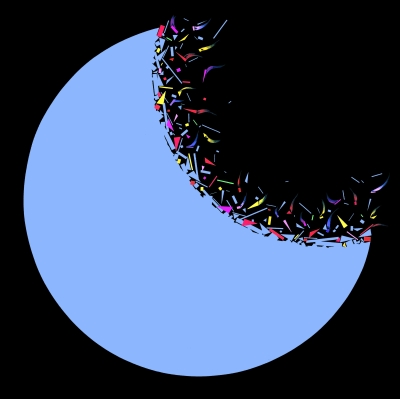
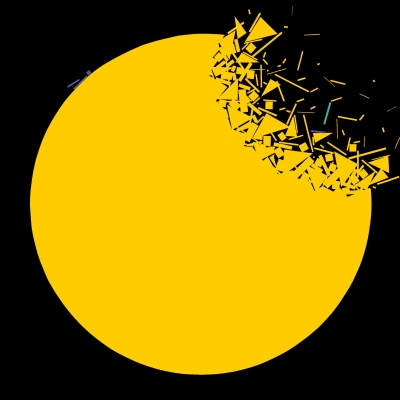
|
|
